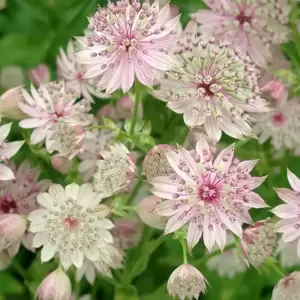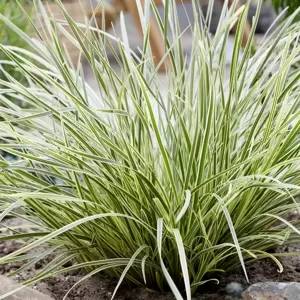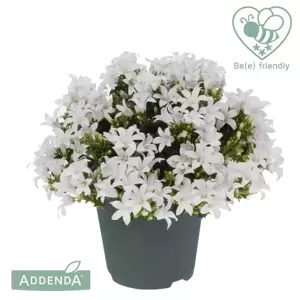Galanthus elwesii
Galanthus elwesii, the greater snowdrop, produces tufts of broad green foliage, with the instantly recogniseable nodding white flowerheads rising up in early spring.
- Nodding white flowers signal the end of winter
- RHS award winning
- Green tufting foliage can be divided for more plants
- Height 30cm - Spread 10cm
Greater Snowdrop
-
EAN code5022903322985
- Pot Size9cm
- AspectEast-facing, North-facing, South-facing, West-facing
- AwardAGM (Award of Garden Merit) RHS
- Flower ColourGreen, White
- Flower FormSingle
- Flowering MonthJanuary, February
- Foliage ColourGreen
- Foliage TypeDeciduous
- Garden StyleCity & Courtyard Garden, Cottage & Informal Garden, Rock Garden, Wildflower Meadow, Woodland Garden
- Hardiness (RHS rating)H5 -15 to -10ºC. Hardy - cold winter
- Height30cm
- Spread10cm
- MoistureMoist but well-drained, Well-drained
- pHAcid, Alkaline, Neutral
- Plant HabitTufted
- Plant TypePerennial
- Planting TypesBorders and Beds, Underplanting of Deciduous Trees and Shrubs, Underplanting of Roses and Shrubs
- Season of InterestSpring
- Soil TypeChalk, Clay, Loam, Sand
- Special AttributesEasy to Grow, Low Maintenance, Scented Flowers
- SunlightPartial Shade
- ToxicityPoisonous
Snowdrops & Bluebells
- The first reference to snowdrops in our gardens dates back to 1597.
- Carl Linnaeus who in 1754 named them Galanthus Nivalis, meaning “milk flower of the snow” in Greek/Latin.
- Snowdrops were anciently known as “Candlemas bells”, reflecting their traditional flowering time around early February time.
- A new variety named Galanthus Elwesii was first introduced in 1874 from Turkey.
Snowdrop Q&A:
1. How often should I divide my clumps of snowdrops?
You can leave them to grow bigger and flowering should not be restricted for many years. Dividing them every two years can improve your stocks quickly. For the best results, divide them immediately after flowering, whilst the leave are still green.
2. Why aren’t my snowdrops multiplying?
This could be because you are growing them in hard, dry, clay soil and are being baked in the sun. Snowdrops are best under trees and shrubs due to the lack of light.
3. What is the best type of soil for snowdrops?
Snowdrops will grow in most garden soils, but will not if the soil is dry for long periods. Also maintain levels of organic matter, as soils low in organic matter will produce poorer results.
4. Are snowdrops worth cutting and bringing indoors?
As long as you’ve got enough in the garden display, then yes! Warm indoor air helps release the scent of flowers, so they’ll smell stronger. To make them last as long as possible cut as much stalk off with the flowers as you can and keep them cool. Try not to remove the leaves, as that weakens the bulbs.
5. How close to trees can I plant snowdrops?
Don’t plant them too close as snowdrops do not do well in heavy shade. So it is best to plant snowdrops towards the edge of the tree canopy. This also makes planting easier because the soil will not be as dry or as full of roots.
Snowdrop Tips:
- Avoid planting snowdrop on its own, as they’re much better in small clumps. This will produce a better and more visual display.
- You will need to water and look after snowdrops after moving/planting them.
- To divide an existing clump, dig it up and split it. Put half back in the same hole, so there’s still a substantial clump. Then take the other half and split again. This is the best way to form big patches quickly.
Easy As 1.2.3 – Snowdrops:
1. Lift them – Snowdrops will spread to create a carpet across your garden. To encourage this, and keep them healthy and vigorous, divide clumps as the flowers fade.
2. Divide them – Tease the clumps apart by hand, taking care not to tear the root structure. Once you have separated them into clusters of 3-5 bulbs, replant them.
3. Replant them – Make fresh planting holes nearby, leaving space for the clumps to grow again (about 15cm apart). Improve the soil before planting with compost for best results.
English, Spanish and Hybrid bluebells – How to spot the difference:
- What colours are the flowers? - Native species’ flowers are a deep blue, whilst Spanish bluebells tend to have pale-blue/pink flowers.
- Do the flowers have any scent? - The native bluebell has a strong sweet smell; Spanish ones are not scented.
- What shape are the flowers? - Flowers of native bluebells are narrow and tubular, with the tips of the petals rolled back. Whereas the Spanish bluebells are more bell shaped.
- How are the flowers arranged? - The native bluebell has flowers on mostly one side of the stem. Spanish bluebells tend to have them arranged around the whole stem.
- What colour is the pollen? - Native bluebells have creamy white pollen, while Spanish bluebells have pale green/blue pollen.
- What shape are the leaves? - The native bluebell has narrow leaves that are pointed at the tip; whereas Spanish ones have much broader leaves with a rounded tip.
Hybrids are between the two, as they are very common and share the characteristics of both the Native and Spanish plants.
The majority of our national delivery options fall under the categories below. Certain oversized or age restricted items carry an additional delivery charge, however this will be clearly displayed in your basket before checkout.
Tracked Delivery (Express) - £6.99
Zone 1 - England, Wales & Scotland (excluding Highlands & Islands)
- Orders are dispatched within two working days
- Parcels are sent via DX or Parcelforce on a next day service, requiring a signature on delivery or safe place instructions
- Fully tracked from door to door with text or email notifications along the way to keep you informed
- 2 hour time slot notification
- Dispatch days Monday - Thursday (excluding Bank Holidays)
- Delivery days Tuesday - Friday
Tracked Delivery (2-4 Days) - £14.99
Zone 2 – Highlands & Islands of Scotland
- Parcels are sent via a tracked 48 service, requiring a signature on delivery or safe place instructions
- Tracking code provided on dispatch. Email or SMS notification on day of delivery
- Orders dispatched within two working days
- Please expect 2-4 days for delivery
- List of applicable postcodes
Tracked Delivery (3-4 Days) - £14.99
Zone 3 – Isle of Man, Isle of Wight & Isles of Scilly
- Parcels are sent via a tracked 48 service, requiring a signature on delivery or safe place instructions
- Tracking code provided on dispatch. Email or SMS notification on day of delivery
- Orders dispatched within two working days
- Please expect 3-4 days for delivery
Parcel Tracking
Your order will be sent using a fully tracked service, providing us with some information on the parcel's status, location and route. It also allows us to provide you with the same information. Once your order has been dispatched you will receive an email (please check spam/junk email folders) with a tracking code and instructions on how this information can be retrieved.
Write a review about "Galanthus elwesii 9cm"
We want to know your opinion! Write a review about the product “Galanthus elwesii 9cm” and get a chance to win a National Gardening Gift Voucher of £25!





